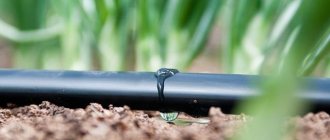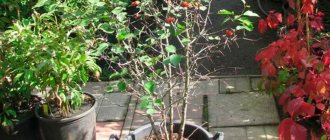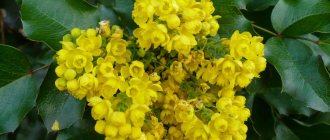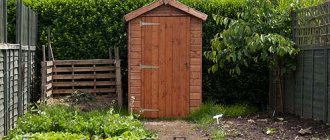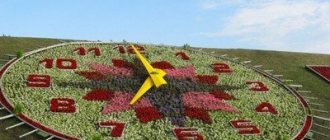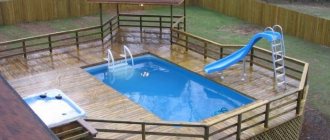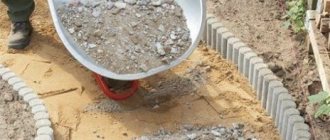Which is better: sand, clay or loam?
For any type of plant, loose, nutrient-rich and light soil, namely loam, is best suited. It is easy to distinguish it from sand; if you take the loam in your palm, moisten it, you can roll it into a ball. If this fails, then you have ordinary sand, and if it rolls into separate pieces, then it is sandy loam.
Good soil will allow light, moisture and oxygen to pass through. Clay does not have this property. It is difficult to pass moisture through it, it warms up slowly, and after rain a crust forms on the surface. Clay dries quickly and contains few useful substances.
To improve such lands, peat, grass or compost should be added to their surface. They will help restore your supply of nutrients. To improve the quality of clay soil, you can also add sand, turf soil, crushed brick, straw, twigs or bark. Thanks to such components, the soil will be able to retain the necessary moisture. It should also be dug up frequently, because a crust forms on it, which impedes the access of oxygen.
For clay soil, horse and sheep manure is best suited, for sandy soil - cow and pig manure.
Soil types
Plants receive sufficient moisture and microelements from fertile soil. If the soil yields less and less every year, it means it is bad and barren. Due to the peculiarities of its structure, practically no nutrients are supplied to plants. Depending on the composition of the soil there are:
- sandy;
- sandy loam;
- clayey;
- loamy.
Sandy soil is easy to loosen, it drains water well, quickly warms up, aerates and, at the same time, quickly cools and dries out. The main disadvantage of sandy soils is that they do not retain minerals. All applied fertilizers are easily washed away by rain or watering.
Sandy loam soil is very similar in properties to sandy soil: it heats up quickly, has good air permeability and is easy to work with. However, it contains a lot of clay compounds, and, therefore, it retains mineral and organic fertilizers better. Sandy loam soils retain heat longer, allow less moisture to pass through, and dry out more slowly.
Clay soil is the least fertile. Its structure is poorly aerated and takes a long time to warm up. The soil is poorly permeable to moisture. This causes the clay surface to float, and when it dries, a soil crust forms. Exceptions are clayey chernozems.
Loamy soil is the golden mean between clayey and sandy loam. It is easy to process, it is breathable, allows water to pass through well and distributes it evenly throughout the entire thickness, and retains heat. This is the most suitable type of soil for growing garden crops.

In addition, gardeners distinguish calcareous soils, acidic soils and solonetzes. Calcareous soils can be either light or heavy. They heat up quickly and dry out, and are poor in manganese and iron. In acidic soil, all useful microelements are found in the lower layers of the soil; there is practically no humus. Solonetzes contain easily soluble salts: sodium sulfate and sodium chloride. When the soil is moistened, the salts dissolve and come to the surface. When the soil dries out, it becomes hard and difficult to cultivate.
Secrets of determining the composition of the soil at the dacha
To determine the type of soil in your garden, you need to take some soil from the plow and mix it with water. You need to get a paste-like mass. After this, a “sausage” is rolled out in your hand:
- It is impossible to form any lump from sandy soil;
- sandy loam soil can be rolled, but the “sausage” does not hold its shape well;
- You can easily roll a “donut” from clay soil;
- if the soil disintegrates when twisted into a donut, it means you have loam in your hands.
Signs of calcareous soil include a light brown color and rocky inclusions. In acidic soil there is a whitish layer similar to ash. Also, a lot of horsetail and sorrel grow on such soil (more about indicator plants). Identifying solonetzes is also not difficult. After getting wet, the soil becomes sticky and structureless and takes a long time to dry.
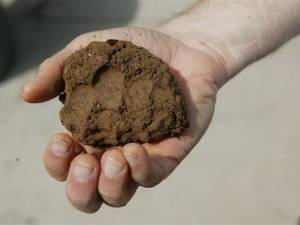
And some more useful tips on how to improve the soil in your summer cottage
- The soil needs to be fed with green manure. These are so-called annual plants that help saturate the soil with useful substances and also improve the microflora. These crops include legumes and cereals. Mixtures of monocultures can also be purchased in stores.
- Give the earth a rest - even the earth wants to breathe air freely. It is this manipulation that will preserve fertility for many years. To do this, it will only take one season without sowing it with anything or fertilizing it. It is best to dig up and add ash or organic matter.
- Manure is one of the richest fertilizers in the world. Preparing the soil at a summer cottage for planting should begin with the application of manure. Its natural composition will not harm either the land or the crop. It is best to use not fresh horse manure, but its compost, that is, dried out.
- Treat the area - there are plants on sale that kill harmful microorganisms from the soil. These include: garlic, wormwood and marigolds. They can be planted with, between or around main crops.
How to improve the soil structure in the garden?
If the soil on your site is depleted, it can be “saved” through a few simple measures.
Changing the composition
The most common way to correct structureless soil is to change its texture and add a significant amount of organic matter. This process is long and physically difficult, but it gives a positive result.
Sandy soils are enriched by adding clay. The soil mixture can be prepared separately in a ratio of 70% base soil and 30% additive. Then you need to select a bed, transfer the soil mixture to it, add 20-40% of manure, compost, humus, and other organic components and carefully dig up the top layer to a depth of 15 cm. In subsequent years, on such beds, systematically under all crops that respond positively to the application organic matter, it is necessary to add humus and compost.
Floating chernozems are enriched with sand (30% of the mass of the main soil) and mature compost or humus is added at the rate of 50-70 kg/sq.m. Dig with 0.5 bayonet shovels. In subsequent years, it is necessary to systematically add loosening materials - humus , sawdust (except coniferous) approximately 20 kg per sq.m. When digging, constantly add fallen leaves, tops and other garden waste, finely cut (3-5 cm) shoots of berries and fruit crops.
We enrich with organic matter
Increased use of mineral fertilizers, herbicides, insecticides and other chemicals gives a one-time increase in yield, but the soil as a whole is depleted of organic matter, which destroys its structure and reduces overall natural fertility. To stop the destructive process, the following agrotechnical measures :
- All plant residues (weeds, healthy tops, fallen leaves, mown grass, manure, sawdust, straw) should be composted. Apply mature compost to all crops during autumn soil preparation.
- In order for the compost laid in the spring to mature for autumn application, it is advisable to treat it with the EM-1 Baikal working solution. Effective microorganisms of the drug will process plant residues in the shortest possible time. The released mineral salts and trace elements in accessible forms will be used by crops, and coarse organic matter will form the soil into small lump-like granules. The size of the granules will increase over time from the size of a wheat grain to a small nut. The soil will become airier, lighter, and free from the floating crust after watering and rain.
Mulching
On all types of soil it is necessary to switch to cultivating crops using mulch. Mulching creates favorable conditions not only for plants, but also for soil inhabitants, the number of which also leads to improved structure and increased soil fertility (worm coprolites). A positive microenvironment is activated, which inhibits pathogenic microflora and heals the soil. Constant mulching of the site is an effective way to structure the soil and increase fertility.
Sand, clay, small crushed stone are the framework of the soil. Its fertility is formed by humus, the active forms of which can also be obtained using vermiculture technology. Californian worms very quickly process materials put into composting, turning them into vermicompost - the most active and environmentally friendly fertilizer.
California worms, or Prospectors
We sow green manure
The use of green manures, or green fertilizers, helps to quickly improve the structure, quality and fertility of the soil. During a short growing season, green manure forms a large above-ground mass and a root system that loosens the soil. They can be sown in spring and early autumn.
Green manure can be completely buried in the soil or mowed and composted, and the remainder can be used as fertilizer.
The article shows only some of the most accessible work on restoring and maintaining soil structure. Remember, autumn fires are the enemy of soil fertility. The more plant residues returned to the soil, the better its structure.
Adding sand and compost
These are the best loosening agents for heavy clay soil. You can also add rotted manure to your garden plot. You can do without manure by using leaf compost. It is more effective because the risk of soil contamination by various pathogenic bacteria contained in manure is reduced. We add this component in spring or autumn at the rate of 1.5-2 buckets per 1 m².
To get the desired effect, plant it to a depth of up to 5 cm. I usually dig it with a hoe or a flat cutter and just loosen the soil with compost. This way, the compost will gradually go into deeper layers and make the clay soil loose with good access of moisture and oxygen to the roots. With a deeper embedment of 20-30 centimeters when digging, it will be covered with dead weight and there will be no use from it.

If you are going to use humus instead of compost, then the best option would be horse, rabbit or sheep.
The disadvantage of using organic components is that they improve the structure and composition of clay soil for a very long time. To speed up this process, combine organic matter with coarse river sand - 1 bucket per 1 m². It immediately makes the soil loose.
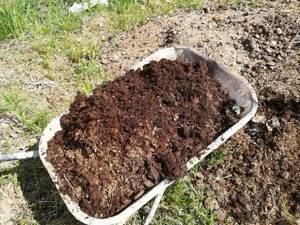
If you apply regularly - every 5 years, you will achieve the desired effect - you will make 15-18 cm of the surface layer of clay fertile, light and loose.
In addition to this mixture, add gravel, rock flour - a bucket of each substance. But this is optional.
Increased fertility
Below are the most effective and safe mechanical methods for improving the fertility of various soils, which are used locally for planting beds. And then they improve the soil environment by adding organic matter, sowing green manure and adding EM preparations.
Sandy soil
If the soil at your summer cottage is sandy, the main tasks are: improving its structure and optimizing its moisture content. The current mixture is the following (for 1 square): manure (4 kg) + lime (0.4 kg). The priority is gradual application of fertilizer. In the fall, dig in half to a depth of 25 cm, in the spring the second half to a depth of 15 cm.
To increase soil fertility, peat, humus, compost or clay flour are regularly added to it, at a rate of 2 buckets per square. After harvesting, the soil is sown with green manure and then incorporated. Mulching with organic matter gives results within a couple of years.
During the cultivation process, strawberries, melons, carrots, and onions can be planted on the soil. Peas, beets, potatoes and cabbage will grow worse.
Many gardeners create an artificial fertile layer. In place of the beds, a layer of clay 5-6 cm thick is poured. A 30-35 cm layer of sandy loam soil is poured on top.
Although sandy loam soils are considered good for growing garden crops, we recommend regularly fertilizing with organic matter, sowing green manure and mulching the soil.
Clay soil
Improving fertility in this case involves adding 3 kg of organic fertilizer (manure or compost), 0.4 kg of lime and 0.3 kg of ash to each square in the fall. At the same time, manure and ash are added every year, and lime once every four years.
Clay soil is heavy, so it must be dug to a depth of at least 25 cm. Seeds are sown close to the surface, and seedlings are planted at a slight slope so that the roots are not in too warm layers. Potatoes are planted to a depth of no more than 8 cm, and composted peat is added to each hole. And during the last hilling, the height of the ridge should be about 18 cm.
Everything grows on loam, and there is no need to improve its fertility. But to maintain the properties of the soil, it is mulched. In traditional agricultural technology, for autumn digging, 3 kg of manure is applied to each square, and the plants are fed with mineral fertilizers. Those who refuse digging and mineral water - mulch, green manure, and occasionally add EM preparations.
Acidic soil
Lime or wood ash is added to such soil. It takes about a kilogram of limestone per square. Plants receive organic and mineral fertilizers.
Calcareous soil
To improve plant growth, organic and potassium fertilizers are regularly added to the soil. To grow potatoes, carrots, sorrel, tomatoes, pumpkins, cucumbers or lettuce, the soil can be acidified with urea or ammonium sulfate.
Solontsy
When plowing the land, phosphogypsum is added (200 g per square). You can use finely ground gypsum. Experienced gardeners recommend plowing the soil with gypsum in the first year, and with manure in the second year. Calcium sulfate is regularly added to solonetzes. It neutralizes the salts of the lower layers, making the soil structural and well-permeable to water.
